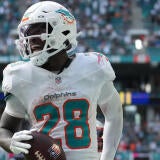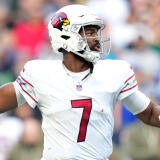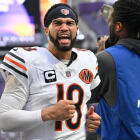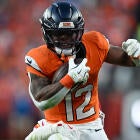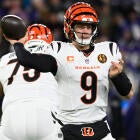What Urban Meyer means for Jaguars offense in Fantasy: Play-calling changes will impact James Robinson most
The Jacksonville offense all of the sudden has a surprisingly positive outlook for 2021
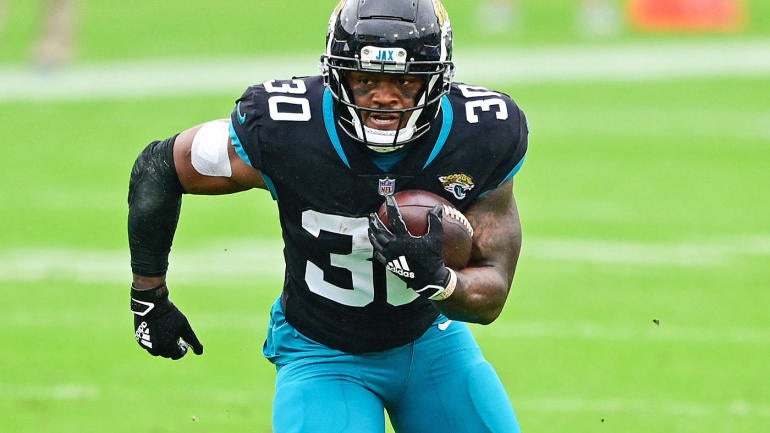
When Jaguars coach Urban Meyer declared at his introductory press conference "I'm not going to be the playcaller," it meant the new, expensive and wildly successful collegiate mastermind wouldn't be in charge of calling the offense. That role, apparently, will go to long-time NFL offensive coordinator Darrell Bevell, formerly with the Lions. But Bevell will "adapt" to Meyer's vision, according to the head coach.
"The flexibility and not rigidness was very important to me because we do have the first pick in the draft and there is a vision I have about the style of offense," Meyer said in mid-February. "I'm certainly not going to call plays, that's his responsibility, but I have a real clear vision about what I want the offense to look like."
There are lots of things Meyer did well at during stops at Utah, Florida and Ohio State, but two areas stood out: he relied on a quarterback who could move, and he curated an offense around him using the talent he had. From Alex Smith to Tim Tebow to J.T. Barrett, a mobile quarterback was a prerequisite nearly every season, but special players like Percy Harvin, Ezekiel Elliott and Michael Thomas were prominently featured.
To that end, we're going to take a leap of faith and assume the Jaguars will spend the No. 1 overall pick in the 2021 NFL Draft on Clemson quarterback Trevor Lawrence. While Lawrence isn't the same kind of rusher as, say, Lamar Jackson or Josh Allen, he is a mover who contributed over 700 yards and 17 rushing scores over the past two seasons. He's absolutely mobile.
Plus, Meyer loves him.
We're also going to have to assume that Meyer, and Bevell, and passing-game coordinator Brian Schottenheimer, will build an offense tailored to the strengths Lawrence showed over three years at Clemson. And as it turns out, Clemson's offense isn't a far leap from the one-back, spread-offense style Meyer preferred when he coached.
New play-caller series: Falcons | Chargers | Lions
Pass-run ratios
Urban Meyer's last two seasons at Ohio State:
| Year | Pass | Run |
|---|---|---|
| 2018 | 51 | 49 |
| 2017 | 45 | 55 |
Why just look at the last two years of Meyer's tenure? Because the 2017 ratio is pretty much in line with nearly every single previous year of his coaching career going back to Florida. The 2018 year is an outlier from when Meyer opted to throw more and run less (Dwayne Haskins was his quarterback). In no season did Meyer choose to roll with a wild pass-happy approach.
"I'll fight anybody on this -- you have to run the football to be successful at the highest level," Meyer said last year when referencing having a "horse" in his offenses.
Mesh that with his penchant for quarterbacks who are willing to run out of spread RPOs, and pass attempts could get pushed down considerably.
Pass-run ratios from Lawrence's last three seasons at Clemson:
| Year | Pass | Run |
|---|---|---|
| 2020 | 55 | 45 |
| 2019 | 48 | 52 |
| 2018 | 48 | 52 |
| Total | 50 | 50 |
Lawrence wasn't exactly a bystander when the Tigers ranked 10th in 2018 and 13th in 2019 in rushing, but he wasn't tasked with taking over the offense with his arm much until 2020. He averaged 33.4 pass attempts per game in his final year, up from 27.1 the year prior. That's just how Clemson's offense operated, which isn't unlike how Meyer's offenses operated. Don't expect a prolific passing offense in Jacksonville.
I could bring up Bevell's track record, but it won't help. Bevell was known as a run-heavy playcaller when he had Adrian Peterson in Minnesota and Marshawn Lynch in Seattle (duh), but spent the past three seasons in Motown calling pass plays at least 60% of the time. Bevell could help expand Lawrence's passing knowledge but figures to be even-steven in the pass-run ratio so long as the Jaguars defense doesn't crumble like it did in 2020.
This means we shouldn't expect Lawrence's stats to be saucy in his first season unless he runs for a bunch of touchdowns. No one should rule that out, but since there are around 15 quarterbacks with a higher profile, Lawrence at the very least shouldn't be over-drafted. He'll be a late-round pick in every redraft league and a Round 1 choice in rookie-only drafts (and potentially the 1.01 in Dynasty SuperFlex).
RB rush attempts per game
RB rushes during Meyer's last two seasons at Ohio State:
| Year | RB rushes per game | % of total plays |
|---|---|---|
| 2018 | 31.3 | 38.7 |
| 2017 | 26.2 | 35.4 |
You already learned that Meyer liked to run the ball a lot -- now you're seeing just how often his running backs actually ran it. In 2018, his running backs got close to 40% of the total offense on just carries, a number Meyer also got close to in 2015 with 25.4 rushes per game, or 37% of total plays. In those years -- 2015 and 2018 -- Meyer had a dynamic lead running back (Ezekiel Elliott ate up carries in 2015, JK Dobbins led a tandem in 2018). Dobbins also led the way in 2017 but lost a lot of work to Barrett. Ultimately, his running backs were called upon to take a lot of carries, but Meyer also used quarterbacks and wide receivers (Harvin, Curtis Samuel) to help carry the mail.
RB rushes during Lawrence's last three seasons at Clemson:
| Year | RB rushes per game | % of total plays |
|---|---|---|
| 2020 | 24.8 | 32.6 |
| 2019 | 27.6 | 38.3 |
| 2018 | 29.5 | 41 |
Would you believe Lawrence dealt with more running back carries during his time at Clemson than other quarterbacks under Meyer? It probably speaks to Clemson's personnel and offensive philosophies rather than Lawrence's talent, though it also clearly suggests that Lawrence wasn't relied upon as a rusher as much as other passers coached up by Meyer.
If Meyer builds an offensive line he loves and has the running backs he trusts, we could see the Jaguars lean on the run a bunch, certainly more than the 17.6 times per game the franchise did in 2020. Several other factors play into this, including how quickly Lawrence draws the respect of opposing defenses, but it's likely the Jaguars become a much more nuanced run team.
Meyer inherited James Robinson from the previous coaching staff. On one hand, Robinson gives Meyer a lead back with incredible vision and power with deceptive speed. But Meyer figures to add to his running back stable considering the rest of the guys on the Jaguars' depth chart. There's a chance Robinson won't be the only beneficiary of Meyer's strong run-game wish, but he figures to be the main guy. That'll keep him in early-round consideration, even if some of his short-yardage touchdown opportunities are stolen by Lawrence.
Reception distribution
Percentage of receptions to Meyer's skill-position players:
| Year | RB rec % | WR rec % | TE rec % |
|---|---|---|---|
| 2018 | 14.1 | 78.3 | 7.6 |
| 2017 | 13.6 | 73.9 | 12.5 |
It won't do a whole lot of good to delve into Meyer's reception tendencies because he's done a good job over his career leaning on his playmakers regardless of position. For example, his tight ends at Ohio State never really had much work, but think back to fluid movement guys like Trey Burton and Jordan Reed at Florida and you'll recognize their involvement. In 2009, Aaron Hernandez caught 27.3% of the team's receptions. If the Jaguars end up with a fast tight end who can create mismatches, Meyer will find ways to use him.
It's also worth mentioning that Bevell has a nice track record of using his tight end. Between his three years with the Lions and 12 seasons between the Seahawks and Vikings, tight ends caught at least 19% of all receptions in 10 seasons. If Bevell has any influence, and who knows how much he will actually have, tight ends could be incorporated into the offense.
Percentage of receptions to Lawrence's skill-position players at Clemson:
| Year | RB rec % | WR rec % | TE rec % |
|---|---|---|---|
| 2020 | 19.3 | 65.6 | 15 |
| 2019 | 16.9 | 75.1 | 8 |
| 2018 | 7.9 | 86.9 | 5.2 |
Clemson's coaches aren't stupid. They knew they had a prodigy quarterback and they had some excellent receivers and a speedy, shifty running back working behind a very good offensive line. Like Meyer, they used their strengths to their advantage.
But if Lawrence remains in a spread system, which is expected, we could infer this to mean he'll lean on his receivers more than other positions. Call it a tendency, call it playing to the offense's strengths, but it's more information suggesting that the Jaguars' wide receivers will be his most prolific targets.
This is leading people to get excited about D.J. Chark again. He's easily the Jaguars' best wide receiver currently on the roster, but he's coming off of a disappointing third season. Pretty much every metric, from targets per game to catch rate to yards per target to yards after catch, went down from his breakout 2019. He also wasn't productive as a deep-ball receiver, though that can be partially put on his quarterbacks: Of his 92 targets, 31 were deep passes in which only 11 were deemed catchable (and he caught 10 of those).
By comparison, Lawrence was 22 of 51 on passes of 20-plus yards, according to Pro Football Focus, leading to 10 touchdowns and an incredible 97.7 grade. Plus, Bevell called 70 deep throws (20-plus yards) in 2020 and 88 in 2019, spreading his wings over his final two years in Detroit. And as much as Meyer may want to run, he'll mix in some deep throws as well. Chark's deep-ball game on top of any other ways he can expand his role could make him an outrageous wideout for Fantasy in 2021.
Finally, keep an eye on who the Jaguars' slot receiver is. Lawrence found a groove in 2020 with Amari Rodgers, who is among the best slot prospects in the 2021 NFL Draft. Short, speedy, shifty receivers like Percy Harvin and Parris Campbell also starred in prior iterations of Urban Meyer's offenses. This could lead to someone landing a high-volume target role in Jacksonville -- and a sleeper in 2021 Fantasy drafts. Curtis Samuel's working knowledge of Meyer's offenses, prior slot usage (60.6% of snaps in 2020) and NFL experience make the free-agent-to-be a seamless fit.


